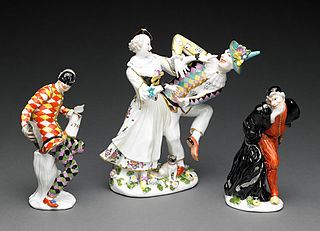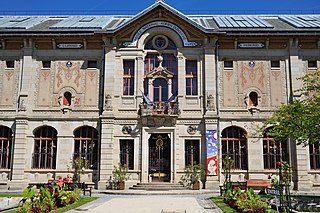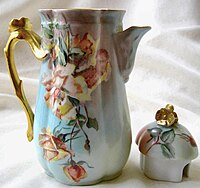
Porcelain is a ceramic material made by heating raw materials, generally including kaolinite, in a kiln to temperatures between 1,200 and 1,400 °C. The greater strength and translucence of porcelain, relative to other types of pottery, arise mainly from vitrification and the formation of the mineral mullite within the body at these high temperatures. End applications include tableware, decorative ware such as figurines, toilets and washbasins, and products in technology and industry such as electrical insulators and laboratory ware.

Limoges is a city and commune, and the prefecture of the Haute-Vienne department in west-central France. It was the administrative capital of the former Limousin region. Situated on the first western foothills of the Massif Central, Limoges is crossed by the river Vienne, of which it was originally the first ford crossing point.

Vitreous enamel, also called porcelain enamel, is a material made by fusing powdered glass to a substrate by firing, usually between 750 and 850 °C. The powder melts, flows, and then hardens to a smooth, durable vitreous coating. The word vitreous comes from the Latin vitreus, meaning "glassy".

The Vincennes porcelain manufactory was established in 1740 in the disused royal Château de Vincennes, in Vincennes, east of Paris, which was from the start the main market for its wares.

Soft-paste porcelain is a type of ceramic material in pottery, usually accepted as a type of porcelain. It is weaker than "true" hard-paste porcelain, and does not require either its high firing temperatures or special mineral ingredients. There are many types, using a range of materials. The material originated in the attempts by many European potters to replicate hard-paste Chinese export porcelain, especially in the 18th century, and the best versions match hard-paste in whiteness and translucency, but not in strength. But the look and feel of the material can be highly attractive, and it can take painted decoration very well.

Biscuit porcelain, bisque porcelain or bisque is unglazed, white porcelain treated as a final product, with a matte appearance and texture to the touch. It has been widely used in European pottery, mainly for sculptural and decorative objects that are not tableware and so do not need a glaze for protection.

In pottery hausmaler is a term for the artist, the style, and the pieces in hausmalerei, the process of buying pieces of pottery as plain "blanks", and then painting them in small workshops, or the homes of painters, before a final firing. In European pottery of the 17th to 19th centuries this was at certain times and places a significant part of production, and the decoration could be of very high quality. In England this was referred to as "outside decoration" and was also very important in the 18th and early 19th century, with some revival in the 20th.

Meissen porcelain or Meissen china was the first European hard-paste porcelain. Early experiments were done in 1708 by Ehrenfried Walther von Tschirnhaus. After his death that October, Johann Friedrich Böttger continued von Tschirnhaus's work and brought this type of porcelain to the market, financed by Augustus the Strong, King of Poland and Elector of Saxony. The production of porcelain in the royal factory at Meissen, near Dresden, started in 1710 and attracted artists and artisans to establish, arguably, the most famous porcelain manufacturer known throughout the world. Its signature logo, the crossed swords, was introduced in 1720 to protect its production; the mark of the swords is reportedly one of the oldest trademarks in existence.

The Manufacture nationale de Sèvres is one of the principal European porcelain factories. It is located in Sèvres, Hauts-de-Seine, France. It is the continuation of Vincennes porcelain, founded in 1740, which moved to Sèvres in 1756. It has been owned by the French crown or government since 1759.

Mintons was a major company in Staffordshire pottery, "Europe's leading ceramic factory during the Victorian era", an independent business from 1793 to 1968. It was a leader in ceramic design, working in a number of different ceramic bodies, decorative techniques, and "a glorious pot-pourri of styles - Rococo shapes with Oriental motifs, Classical shapes with Medieval designs and Art Nouveau borders were among the many wonderful concoctions". As well as pottery vessels and sculptures, the firm was a leading manufacturer of tiles and other architectural ceramics, producing work for both the Houses of Parliament and United States Capitol.

The Frankenthal Porcelain Factory was one of the greatest porcelain manufacturers of Germany and operated in Frankenthal in the Rhineland-Palatinate between 1755 and 1799. From the start they made hard-paste porcelain, and produced both figurines and dishware of very high quality, somewhat reflecting in style the French origin of the business, especially in their floral painting. Initially they were a private business, but from 1761 were owned by the local ruler, like most German porcelain factories of the period.

The Imperial Porcelain Factory, also known as the Imperial Porcelain Manufactory, is a producer of hand-painted ceramics in Saint Petersburg, Russia. It was established by Dmitry Ivanovich Vinogradov in 1744 and was supported by the Russian tsars since Empress Elizabeth. Many still refer to the factory by its well-known former name, the Lomonosov Porcelain Factory.

The manufacture de Nast was a prominent hard-paste porcelain factory founded in Paris in 1783 by Jean Népomucène Hermann Nast, an Austrian born French citizen. Nast porcelain was produced until 1835, and was one of a number of factories making very high-quality porcelain in Paris in this period, such as Dihl and Guérhard. This contrasted with London, where the factories had all closed or removed north by 1775, although the capital remained, like Paris, a centre for decorating plain "blanks" made elsewhere - in France often in Limoges porcelain.

Chantilly porcelain is French soft-paste porcelain produced between 1730 and 1800 by the manufactory of Chantilly in Oise, France. The wares are usually divided into three periods, 1730–1751, 1751–1760, and a gradual decline from 1760 to 1800.

French porcelain has a history spanning a period from the 17th century to the present. The French were heavily involved in the early European efforts to discover the secrets of making the hard-paste porcelain known from Chinese and Japanese export porcelain. They succeeded in developing soft-paste porcelain, but Meissen porcelain was the first to make true hard-paste, around 1710, and the French took over 50 years to catch up with Meissen and the other German factories.

Rouen porcelain is soft-paste porcelain made in the city of Rouen, Normandy, France, during a brief period from about 1673 to 1696. It was the earliest French porcelain, but was probably never made on a commercial basis; only nine pieces are now thought to survive.

Niderviller faience is one of the most famous French pottery manufacturers. It has been located in the village of Niderviller, Lorraine, France since 1735. It began as a maker of faïence, and returned to making this after a period in the mid-18th century when it also made hard-paste porcelain. In both materials, it made heavy use of deep magenta or pink in its decoration.

China painting, or porcelain painting, is the decoration of glazed porcelain objects such as plates, bowls, vases or statues. The body of the object may be hard-paste porcelain, developed in China in the 7th or 8th century, or soft-paste porcelain, developed in 18th-century Europe. The broader term ceramic painting includes painted decoration on lead-glazed earthenware such as creamware or tin-glazed pottery such as maiolica or faience.

The Londonderry Vase is a hard-paste porcelain vase, standing at 54 inches tall. It is decorated with polychrome enamels, gilding and gilt bronze mounts. It bears the Sèvres mark, two intersecting Ls with a letter in the center denoting its creation year (1813-1815) and a crown over the L's to mark it as hard-paste. The vase was commissioned by Napoleon around 1805 to be created by the Sèvres Manufactory. The vase is currently on display at the Art Institute of Chicago.

Musée national Adrien-Dubouché is a French national museum dedicated to Limoges porcelain and the history of ceramics. Founded in 1845 and located in Limoges (Haute-Vienne), it is part of the Cité de la céramique - Sèvres et Limoges public establishment.























